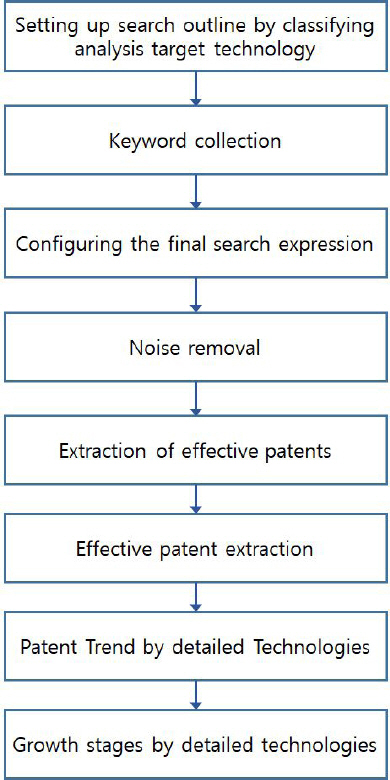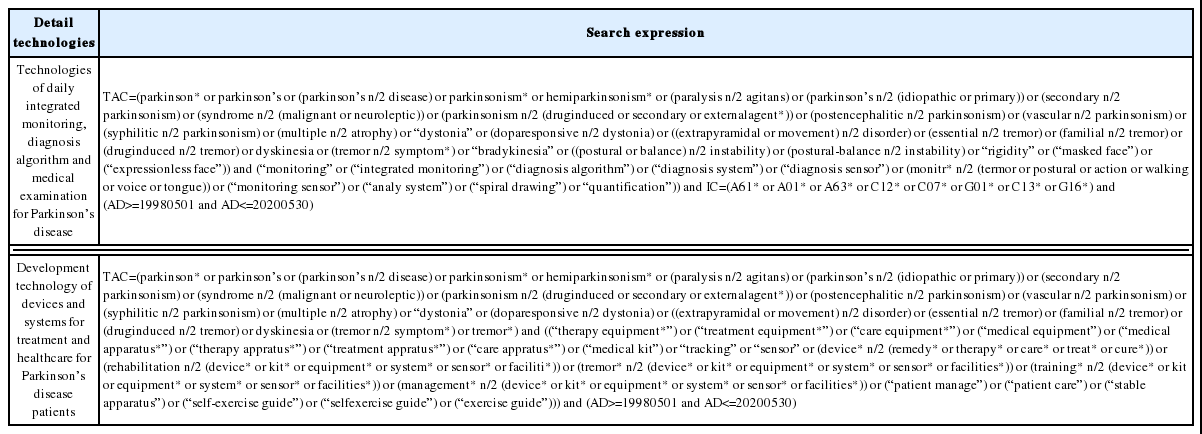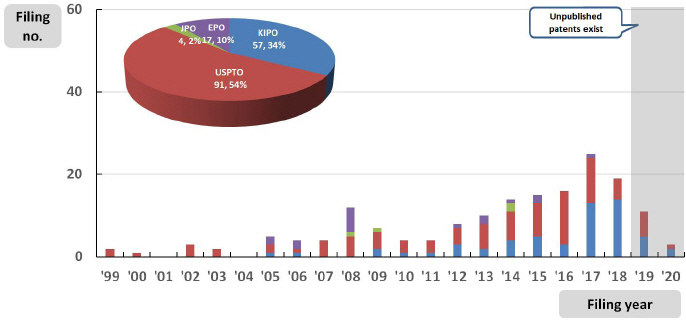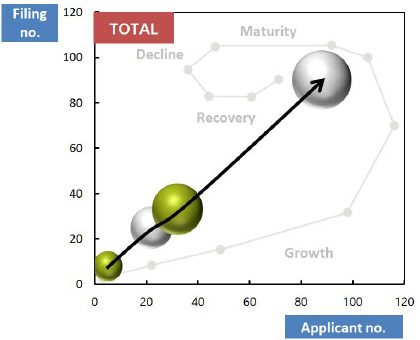파킨슨병의 건강검진 및 일상 모니터링, 관리 기술의 특허 동향 분석
Analysis of Patent Trends for Examination, Monitoring, and Healthcare of Parkinson’s Disease
Article information
Abstract
Objectives:
Parkinson’s disease (PD) is a neurodegenerative disease of the elderly characterized by impaired behavior from lack of dopamine secretion. However, no accurate quantitative diagnosis method has been established. The purpose of this study was to analyze the patent trends (PTs) of health examination and daily monitoring/healthcare technology for PD.
Methods:
For analyzing PTs, a search summary for classifying each analysis target technology was set, and a final search formula was constructed by collecting keywords. After constructing a database of related patents through the final search formula, noise was removed to extract valid patents. PTs by major countries were analyzed using the valid patents, and PTs and growth stages were analyzed by the detailed technologies.
Results:
The survey analysis showed that, despite the existence of unpublished patents between 2018 and 2020, patent activity has increased rapidly in the recent period, and this increasing trend was led by the USA. This technology is considered to be in its early- or mid-stage growth period, which means that the marketability is high and the barriers are low. Korea’s market share is only about 25%, but it has a larger number of applications than those of Europe and Japan. Integrated monitoring and diagnosis technologies for PD have a share of 34%.
Conclusion:
The advances in diagnosis and healthcare technology for PD means that traditional Korean medicine must continue to pay attention to related technologies and to review plans that are applicable to clinical practice.
Ⅰ. 서 론
사회적 고령화가 급속도로 진행됨에 따라 노인에게 발생하는 신경퇴행성 질환의 발생률이 증가하고 있다. 특히 파킨슨병은 치매 다음으로 빈번하게 발생되는 병으로 알려져 있고, 운동기능의 장애를 동반함에 따라 노인들의 삶의 질을 저하시키는 주요한 질환이다1,2.
파킨슨병은 뇌의 흑질 부위 신경세포가 손상되어 도파민이라는 호르몬의 분비가 잘 안 되는 경우에 발생한다. 도파민의 분비 조절에 문제가 있으면 먼저 손이 떨리는 진전 증상으로 시작해 장차 보행 장애, 무표정, 평형감각 상실이 단계별로 나타나며, 또한 우울증, 배뇨장애, 소화 장애 등이 나타난다3,4. 흑질 부위 신경세포가 손상되는 이유는 의학적으로 아직 정확히 밝혀지지 않고 있다. 파킨슨병의 진단은 Unified Parkinson’s Disease Rating Scale(UPDRS)5,6라는 척도 검사를 통해 하고 도파민운반체 밀도를 측정하는 뇌 도파민 운반체 양전자방출단층촬영(FP-CIT PET/CT) 영상화7,8를 참고하지만, 진단기기로 정량적으로 진단하는 기술은 아직 확정되지 않았다. 그러므로 진단을 정량화하는 진단기기와 파킨슨병의 관리하는 기술을 개발하려는 시도가 꾸준히 진행되고 있다.
파킨슨병 환자의 자세와 동작을 분석하기 위한 장치에 대한 연구9-14, 파킨슨병의 구강 근육의 경직에 의해 음성15-19 특성을 찾으려는 연구, 그리고 안면 근육의 경직에 의해 무표정 현상20,21이 나타내는 연구가 선행되고 있다.
본 연구에서는 파킨슨병의 정량적 진단 및 치료에 필요한 파킨슨병의 건강검진 및 일상 모니터링, 관리 기술에 대한 특허 동향22 파악을 수행하였다. 이를 통하여 기술에 대한 특허 현황, 국가별 기술경쟁력 등의 정밀한 분석 결과를 전략적인 연구개발 계획 수립에 활용할 수 있도록 함으로써 중복 연구를 방지하고 유사 연구개발을 수행하고자 하는 독자에게 객관적인 특허 동향 정보를 제공하고자 하였다.
Ⅱ. 연구방법
1. 분석 대상 특허 및 검색 DB
파킨슨병의 건강검진 및 일상 모니터링, 관리 기술의 특허 분석은 과거부터 2020년 5월까지의 한국, 미국, 일본, 유럽의 출원 특허로 등록 및 공개된 전체 문서를 대상으로 진행하였고, 검색 DB는 FOCUST를 이용하였다. 기술현황으로 우리는 통합 모니터링 및 검진 기술 및 파킨슨병 환자 치료 및 관리 기술을 Table 1과 같이 세부기술로서 나누어 조사하였다. 전체 특허 동향 분석 순서는 Fig. 1과 같다.
2. 핵심 키워드 및 검색식 도출
먼저 저자들은 각자의 관련 키워드를 수집하였는데, 자세 균형에 대한 키워드는 자세 균형(postural balance), 자세 불안정(postural instability), 압력 중심(center of pressure), 낙상(fall), 힘판(force plate), 정적 자세 균형(static postural balance), 동적 자세 균형(dynamic postural balance)이었고, 파킨슨병 진전 관련 키워드는 진전(tremor), 안정성 진전(resting tremor), 활동성 진전(action tremor), 진전 평가(tremor assessment), 진전 정량화(tremor quantification), 나선 그리기(spiral drawing), 자이로 센서(gyro sensor), 가속도 센서 (accelerometer), 진전 태블릿(tremor tablet) 이었고, 파킨슨병 동작 측정 관련 키워드는 완서증(bradykinesia), 자이로 센서(gyro sensor), 가속도 센서(accelerometer), 파킨슨병 정량화(Parkinson quantification), finger tapping, rapid alternating movement of hands, toe tapping, 착용형 센서(wearable sensor), ADL(activity of daily living) 모니터링(monitoring)이었다.
음성에 관한 키워드는 음성 크기(voice magnitude), 음성 주파수(voice frequency) 특성이었고, 안면에 관한 키워드는 얼굴 무표정(expressionless face), 혀에 대한 키워드는 혀 떨림(tongue tremor)이었다. 각자의 수집된 키워드를 특허사무소에서 다양한 질환 특성과 측정 지표들을 결합하여 Table 2와 같이 기술 분류 체계에 따른 최종 검색식을 구하였다.
위의 키워드와 검색식으로 Raw 데이터를 찾아내었다. 찾아진 Raw 데이터에서 파킨슨병의 건강검진 및 일상 모니터링/관리 기술 개발 기술과 무관한 내용의 노이즈 특허는 분석에서 제외하였으며, 노이즈 제거 기준은 특허사무소와의 논의를 통해 결정하였다. Table 3의 노이즈 제거 기준을 토대로 각 소분류별 국가별 유효 특허를 추출하였으며, 추출한 유효데이터로 본 특허 동향 분석을 진행하였다.
3. 특허기술 동향 조사 분석 방법
특허기술 범위에서는 조사대상국인 한국, 미국, 일본 및 유럽에서의 주요 시장국 기술개발 활동 현황과 출원 건수의 증감 정도의 분석을 통한 기술 시장 성장 단계 파악 및 국가 간 기술경쟁력 현황 분석 등을 통해 국가별 발전 동향을 분석한다. 핵심기술 분석에서는 세부기술별로 구간별 특허출원 동향, 주요시장국별 세부 기술 동향을 분석한다. 세부 기술의 발전 가능성 여부도 함께 분석하도록 한다.
Ⅲ. 결 과
1. Raw 데이터 및 유효 특허
Table 4는 검색식에서 구한 Raw 데이터이고, Table 5는 Table 3의 노이즈 조건을 이용하여 제거한 유효 특허를 선발한 결과이다. 선발한 비율은 전체적으로 7.2%이며, 여기서 걸러진 파킨슨병 일상 통합모니터링, 진단 알고리즘 및 건강검진 기술의 출원된 한국특허(Korea Patent, KP) 건수는 58건, 미국특허(US Patent, USP) 건수는 91건, 일본특허(Japan Patent, JP) 건수는 4건, 유럽특허(Europe Patent, EP) 건수는 17건이라 총 170건이었고, 파킨슨병 환자 치료와 환자 관리 시스템을 위한 장치 및 기기 개발 기술의 KP 건수는 39건, USP 건수는 134건, JP 건수는 7건, EP 건수는 31건 이며, 총 211건이었다.
2. 주요 국가별 연도별 특허 동향
파킨슨병의 건강검진 및 일상 모니터링, 관리 기술 개발의 전체 특허 동향을 Fig. 2에서 살펴보면, 초기 분석구간에서는 증가와 반복을 반복하다 최근 구간에서 지속적으로 출원 건수가 증가하는 형태의 증가 추세가 나타나고 있다. 본 기술과 관련된 특허 동향에서 2000년대 초반 10건 내외로 미미하게 출원되다가 2011년 이후 30건 내외로 증가하는 경향을 보여주었다. 다만, 2004년의 감소추세에서 이후 증가하는 추세가 나타나는 바, 최근까지 미국의 흐름이 전체 동향 흐름을 주도하고 있으며, 특히 2016년에서 한국의 출원 건수가 소폭 감소에 따라 전체 동향 또한 감소하는 추세를 나타내며, 이후 미국의 출원이 증가함에 따라 전체 동향이 증가하는 추세를 나타내고 있다.
파킨슨병의 건강검진 및 일상 모니터링, 관리 기술 개발에 대한 국가별 특허 점유 현황을 살펴보면, 한국 78건(22%), 미국 216건(62%), 일본 8건(2%), 유럽 48건(14%)의 특허가 출원되었다. 본 기술은 미국이 가장 많은 특허기술을 점유하고 있는 것으로 나타났다. 분석 구간 초기부터 최근까지 미국의 출원이 전체 특허 정량적 흐름에 영향을 주고 있으며, 미국의 출원이 전체 특허 동향 형태의 주요한 원인으로 나타났다.
파킨슨병의 건강검진 및 일상 모니터링/관리 기술 개발에서 KP은 78건의 특허가 출원된 것으로 나타나며, 2004년 1건의 출원을 시작으로 2013년까지 연 4건 내외의 적은 건의 특허를 출원하다가 2015년 8건으로 증가한 후 2017년 18건으로 가장 많은 출원 건수를 나타냈다.
미국은 216건의 특허가 출원된 것으로 나타나며, 1999년 2건을 시작으로 2003년 8건으로 증가한 후 감소하다 2007년 14건으로 소폭 증가하였다. 특히 2013년 19건으로 증가 한 후 현재까지 20건 내외의 꾸준한 출원을 보여주고 있다. 특히 분석 구간 초기부터 최근까지 미국의 특허 동향 형태는 전체 특허 흐름과 비슷한 형태로, 한국과 함께 최근 구간의 기술 시장을 주도하고 있는 것으로 판단된다. 미국의 특허 동향은 비교적 2000년대 후반에 증가추세를 나타내고 있으나, 2011년부터 꾸준한 출원 증가 형태가 나타나고 있다. 특히 2015년과 2016년에는 각각 23, 24건으로 이 시기에 가장 높은 출원 건수를 나타내고 있다.
일본은 8건의 특허가 출원된 것으로 나타나며, 2001년 1건을 출원하였으나, 이후 출원이 없다가 2008년 1건이 출원되었고 2014년 3건으로 소폭 증가하였으나 현재까지 이 분야에 출원이 없으며 한국 및 미국과는 대조적인 양상을 나타내고 있다. 일본의 경우 타국가 대비 매우 저조한 출원 건수로서, 양적 흐름으로 기술 수준의 유사 여부를 판단하기는 어려우며 세부 기술 분야에서 일본 특허기술의 세부 내용 파악을 통해 판단할 수 있을 것으로 보인다. EP는 48건으로 나타났으며, 분석 구간 중 2008년에서 7건으로 가장 많이 출원된 후 분석 구간 전체에서 5건 내외로 출원을 지속하고 있는 것으로 나타난다.
3. 세부 기술별 특허 동향
Fig. 3과 같이 전체 기술인 파킨슨병의 건강검진 및 일상 모니터링/관리 기술 개발 관련한 350건(100%)의 특허출원 건수 중 파킨슨병 통합모니터링 및 진단 기술(AA)은 169건(45%), 파킨슨병 환자 치료 및 관리 기술(AB)은 181건(55%)으로 각 세부 기술별 출원 비중을 파악할 수 있다.

Status of patents by detailed technologies.
AA : technologies of integrated monitoring and diagnosis for Parkinson’s disease
AB : technologies of treatment and healthcare for Parkinson’s disease
1) 파킨슨병 통합모니터링 및 진단 기술(AA)
파킨슨병 통합모니터링 및 진단 기술(AA)의 전체 특허 동향을 살펴보면, Fig. 4와 같이 분석 구간 초기에는 적은 출원 건수를 보이거나 출원이 되고 있지 않다가 2008년 소폭 증가 한 후 최근 구간에서 증가하는 추세가 나타나고 있다. 본 세부 기술과 관련된 특허 동향에서 2008년 급격한 증가 이후 2010년과 2011년 감소하는 경향을 보이다 최근 구간에서 증가하는 그래프 형태를 보인다. 다만, 2010년에서 2011년까지의 감소추세에서 이후 2012년에 다시 증가하는 추세가 나타나는 바, 2008년에는 미국과 유럽의 출원 건수가 증가하여 미국과 유럽의 흐름이 이 구간에 동향 흐름을 주도하고 있으며, 2010년에서 2011년 출원 건수의 감소와 2012년부터 최근 구간까지 출원 건수가 증가하는 형태는 미국과 한국의 출원 건수 변화에 따라 전체 동향에 영향을 주고 있으며, 이후 한국과 미국의 출원이 지속적으로 증가함에 따라 전체 동향이 증가하는 추세를 나타내고 있다. AA에 대한 국가별 특허 점유 현황을 살펴보면, KP 57건(34%), USP 91건(54%), JP 4건(2%), EP 17건(10%)의 특허가 출원되어, 본 기술은 미국이 가장 많은 특허기술을 점유하고 있는 것으로 나타난다.
2) 파킨슨병 환자 치료 및 관리 기술(AB)
파킨슨병 환자 치료 및 관리 기술(AB)의 전체 특허 동향을 살펴보면, Fig. 5와 같이 분석 구간 초기에는 출원 건수가 미미하다 2003년과 2007년 소폭 증가 한 후 최근 구간에서 증가하는 추세가 나타나고 있다. 본 세부 기술과 관련된 특허 동향에서 2007년 급격한 증가 이후 2008년 감소하는 경향을 보이다 최근 구간에서 지속적으로 증가하는 그래프 형태를 보인다. 다만, 2007년과 2016년에서만 한국과 일본의 출원 건수가 없어 이 구간의 감소 형태가 보여 지며, 분석 초기 구간에서 최근 구간까지 출원 건수의 감소와 증가 형태는 미국의 출원 건수 변화에 따라 전체 동향에 영향을 주고 있으며, 이후 미국의 출원이 지속적으로 증가함에 따라 전체 동향이 증가하는 추세를 나타내고 있다. AB에 대한 국가별 특허 점유 현황을 살펴보면, KP 21건(12%), USP 125건(69%), JP 4건(2%), EP 31건(17%)의 특허가 출원되어, 본 기술은 미국이 가장 많은 특허기술을 점유하고 있는 것으로 나타났다.
4. 세부 기술별 특허기술 성장 단계
1) 파킨슨병 통합모니터링 및 진단 기술(AA)
파킨슨병의 건강검진 및 일상 모니터링/관리 기술 개발의 세부 기술별 특허기술 성장단계를 분석하고자, 전체 분석 구간 20년을 5년 단위 4개 구간으로 구분하여, 1구간(1999년~2003년), 2구간(2004년 ~2008년), 3구간(2009년~2013년), 4구간(2014년 ~2018년)을 설정하였다. AA의 성장 단계는 Fig. 6의 그래프 상에서 출원 건수와 출원 인수가 증가하고 있는 형태로, 성장기로 해석할 수 있다. 최근 구간에서 출원 건수와 출원 인수가 모두 증가하는 형태를 나타내고 있으며, 이는 전체 구간에서 지속되고 있는 양상으로 성장기 단계의 형태가 나타나고 있다.
AA의 특허기술 성장 단계는 1구간에서부터 출원 인수와 출원 건수가 증가하였으며, 최근 구간에서도 증가하는 성장기 형태로 보여 진다. AA의 특허기술 성장 단계 분석 대상 데이터는 90건을 대상으로 하여 분석의 효용성이 인정된다고 볼 수 있다.
Fig. 7을 보면, KP의 기술 성장 단계는 USP와 비교적 유사한 형태인 것으로 나타나는 바, 한국 기술의 성장 속도가 미국보다 느리게 진행되고 있으나 출원 인수와 출원 건수 모두 증가하는 성장기 형태로 그래프 상에서 나타났다. KP의 기술 성장 단계는 전체 성장 단계와 유사하게 USP를 쫓아가는 양상이 나타날 것으로 판단되며, 이후에도 출원 건수와 출원 인수 모두 소폭 증가하는 형태가 지속될 것으로 보인다. EP와 JP의 경우, 최근 구간에서 출원 인수와 출원 건수가 증가하였다.
2) 파킨슨병 환자 치료 및 관리 기술(AB)
AB의 성장 단계는 Fig. 8의 그래프 상에서 출원 건수와 출원 인수가 증가하고 있는 형태로, 성장기로 해석할 수 있다. 분석 전 구간에서 출원 건수와 출원 인수가 모두 증가하는 형태를 나타내고 있으며, 이는 1구간 이후부터 지속되고 있는 양상으로 성장기 단계의 형태가 나타나고 있다.
AB의 특허기술 성장 단계는 출원 인수와 출원 건수가 분석 전 구간에서부터 지속적으로 증가하고 있는 성장 단계 형태로 보여 진다. AB의 특허기술 성장 단계 분석 대상 데이터는 95건을 대상으로 하여 분석의 효용성이 인정된다고 볼 수 있다.
Fig. 9와 같이 KP의 기술 성장 단계는 2구간과 3구간 사이에서 정체하는 형태를 보였으나 이후 최근 구간에서 출원 건수와 출원 인수 모두 소폭 증가하여 이 분야의 출원이 다소 늦어졌으나 최근 구간에서 증가하는 성장기 초기 형태로 파악되었다. USP의 기술 성장 단계는 전체구간에서 출원 인수와 출원 건수가 모두 증가하고 특히 최근 구간에서 지속적인 증가를 보이는 성장기 형태로 보여 진다. EP의 성장 단계는 한국과 유사하게 분석 구간 초기 증가 이후 3구간에서 감소 형태를 보였으나, 최근 구간에서 다시 증가하는 성장기 형태를 보였으며, JP의 경우, 최근 구간에서 출원 인수와 출원 건수가 미미하게 증가하였다.
Ⅳ. 고 찰
파킨슨병의 건강검진 및 일상 모니터링/관리 기술 개발에서 한국의 특허 동향은 비교적 2000년대 후반에 증가추세를 나타내고 있으나, 2015년부터 2018년 사이에서 비교적 소폭의 증가한 형태가 나타나고 있다. 특히 2016년에는 3건으로 급격히 감소한 형태로, 이 시기에 대한 정확한 분석이 필요한 것으로 판단되며, 다만, 이 시기에 미국의 경우 파킨슨병 진단 및 치료를 위한 2016년에 연구비 총 1조5천2백만 달러를 지원한 것으로 보고되었으나, 한국의 경우 2014년에서 2017년 기준 뇌 질환 관련 총 26억원으로 파킨슨 질환에 대한 연구는 약 3%에 불과한 것으로 확인되어 선진 국가 대비 연구 및 기술개발을 위한 지원이 부족한 것으로 나타났다23. 분석의 범위가 되는 유럽 특허는 유럽 개별국가별로 직접 출원한 특허가 아닌 유럽특허청을 통해 지정국을 정하여 출원하는 건이며, 타 국가 특허와 비교적 기술적 중요도, 상품연계 가능성, 패밀리의 크기가 큰 특징이 있었다. 또한 글로벌 정책으로부터의 영향이 상당히 크다고 할 수 있다. 유럽의 경우, 일본에 비하여 출원 건수는 높으나, 출원 건수가 한국과 미국 대비 미미하여, 전체 특허기술의 증감 추세를 주도하는 구간 또한 나타나지 않으나, 유럽 특허 자체의 기술적 중요도를 고려하여 다출원 기관 및 유럽에 진출한 글로벌 기업의 출원 추세를 살펴보는 것은 의미가 있을 것으로 생각한다.
AA에서 분석 구간 초기부터 최근 구간까지 전체적으로 미국의 출원이 전체 특허 정량적 흐름에 영향을 주고 있으며, 다만 2008년 구간에서 미국과 유럽의 출원이 전체 특허 동향 형태의 변화를 주는 주요한 원인으로 나타나며, 미국은 2006년에 미국신경학회에서 파킨슨병 진단과 치료에 있어서 보다 광범위한 적용을 강조한 임상 가이드라인 발표24한 바 있으며, 이 시기에 기술 개발에 대한 변화가 시작되었을 것으로 보여 진다. 특히, 파킨슨병 유병률 및 발생률의 연구에서 서양의 유병률은 만 명당 535명, 서양의 발생률은 만 명당 6.6명에서 1,250명까지 범위가 매우 넓었다. 서양에 비해 동양은 유병률 및 발생률이 상대적으로 낮은 것으로 보여 지는데, 표준화 유병률이 방문조사에서는 만 명당 5.1명에서 17.7명, 기록 기반 연구에서는 3.6명에서 6.8명으로 보고되고 있다25. 이러한 발생빈도가 미국에서 파킨슨병 진단과 치료에 대한 관심을 가지게 한 이유가 아닐까 생각한다.
AB에서 분석 구간 초기부터 최근 구간까지 전체적으로 미국의 출원이 전체 특허 정량적 흐름에 영향을 주고 있으며, 다만 2007년 구간에서 미국과 유럽의 출원이 전체 특허 동향 형태의 변화를 주는 주요한 원인으로 나타나는 바, 이와 관련하여 전 세계적으로 2007년 12월 이후 파킨슨병 진단을 위한 알고리즘 및 인지기능과 이상 행동장애를 평가하기 위한 신경심리 평가법 등이 함께 시행26된 이후의 변화라 보여졌다.
AA의 유럽과 일본의 출원 건수가 적어 성장 단계 분석의 효용성이 다소 낮은 것으로 판단됨에 따라 향후 동향을 주시할 필요가 있다. 또한 AB의 일본의 출원 건수가 매우 적어 성장 단계 분석의 효용성이 다소 낮은 것으로 판단됨에 따라 향후 동향을 주시할 필요가 있다.
AA의 출원(169건)에 대한 등록 비율을 살펴보면 52%이며, AB의 출원(181건)에 대한 등록 비율을 살펴보면 61%인데 이는 건강검진 또는 진단기기보다는 치료 및 관리 기기의 연구가 좀더 활발하고 등록율도 높음을 알 수 있는데, 현재 활성화된 제품은 치료 및 관리 기기라는 것을 알 수 있다. 하지만 파킨슨병은 기능 진단이 중요하므로 이에 대한 기술 제안이 필요하다.
Fig. 10에서 출원 기관을 살펴보면 미국 Great Lakes NeuroTechnologies사와 Medtronic사의 업체가 선두를 차지하고 있고, 우리나라는 한림대학교, 대구경북과학기술원 등의 학교가 선두에 서 있다. 미국의 록히드마틴사에서 한국으로 파킨슨병 환자의 보행 개선 장치 기술이나 인지능력을 향상시키기 위한 플랫폼 기술에 대한 특허를 출원하였으며, 향후 기술선점을 위해 더 많은 국가에서 한국으로 특허 출원이 예상된다.
국내의 경우 중증 환자의 경우 신체장애와 인지장애 등 복합적인 장애를 동반하며 경제 활동이 활발한 40-50대에서 비율은 치매 대비 약 9배 높으나 파킨슨병은 치매나 뇌졸중에 비해 인지도가 상당히 낮고, 파킨슨병 진단과 치료를 위한 기술 개발에 사회적 지원이 미흡한 현 시점에서 본 기술은 신기술로서 기술적 가치의 향상과 강한 특허 창출 및 선점을 통하여 기술적 문제를 극복하는 신기술로 급부상 할 것이 예상된다.
V. 결 론
파킨슨병의 건강검진 및 일상 모니터링, 관리 기술과 세부 기술의 특허 동향을 분석하여 기술 개발 현황을 파악하였다. 그 결과 한국보다는 미국에서 기술 개발이 활발하게 진행되는 것으로 조사되었으나 한국의 경우도 일본과 유럽에 비하여 출원 건수가 높고 최근 10년 사이 지속적인 출원을 보여주어 이 분야에서 기술 개발이 활발해지고 있다. 이에 따라 한의계에서는 파킨슨병 진단 및 치료 장치가 임상에서 활용할 수 있도록 출현 기술에 대한 꾸준한 관심이 필요할 것이다.
감사의 글
본 특허동향보고서 개발에 도움을 주신 한국특허전략개발원 김건수 연구원과 삼오국제특허법률사무소 이상문 변리사께 감사드립니다.
본 연구는 2020년도 한국한의학연구원의 재원(KSN2012110)과 한국산업기술평가관리원의 재원(10060251)의 지원을 받아 수행된 연구임.
Appendices
【부록】 특허 리스트













